Call Us
+91 9326762293Email Us
contact@chakrayog.comYantras
Yantras
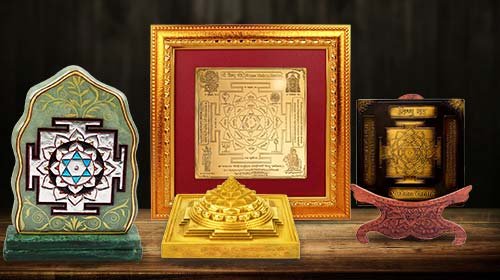
Yantras are mystic diagrams used by people for positive vibrations and the fulfillment of a specific aim. Customarily, yantras are placed near the deities in temples at the altar and at the entrances of homes or worn in the form of a tabeez close to the throat or on the arms. In the southern parts of India, people draw yantras on the floor with multi-hued rangolis during festive times. If you have noticed, the renowned Sri Venkateswara Swamy Temple (Tirupathi) is built in the shape of a Sri Yantra. Before we know the types, uses, and benefits of yantras, let’s answer the basic questions: What does Yantra mean? How does it work? Is it beneficial to have it installed at home?
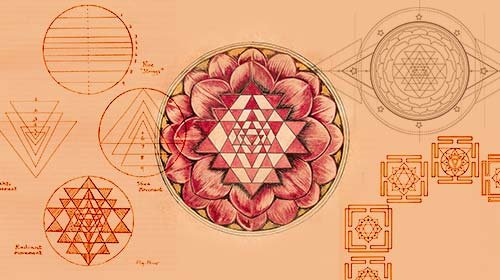
Yantra is referred to as ‘Mandalas’, they are geometrical figures, diagrams or symbols that are characterized by singular forms representing their matching deities and mantras. Yantra in Sanskrit means “machine”, or “instrument”, also “support” or “aid”, correlating to their function as instruments for achieving our spiritual and material objectives. Indeed, the literal meaning of Yantra is: “to control, curb, bind or influence”. Yantra is the physical form of a Mantra and hence it awakens the energy of the deity associated to its mantra when placed anywhere in the environment around. These Vedic diagrams have stronger astronomical esthetics and are the ultimate reality. They can be inscribed in 3 dimensional forms on a plain surface or used as an amulet or charm. Adi Sankaracharya’s Saundarya Lahiri has done a prominent work on the importance of Yantra.
There are different types of Yantra made for different purposes. Yantric geometries are three dimensional in their original states but they are characterized as two dimensional when etched or drawn. Vedic literature based on the occult sciences mention different types of Yantra such as Planetary Yantra, Numerological Yantra, Yantra for different Gods and Goddesses and others. Yantra represent a Physical force or a creative energy. This energy is said to cleanse the environment and electrify the atmosphere with positivity.
Yantras are used in the worship of deities at temples and at home, as well as a tool for meditation. Specific yantras are historically connected with specific deities and/or specific sorts of energies employed for the completion of specific material or spiritual tasks and vows. It becomes a primary instrument in various sadhanas done by the spiritual seeker. Yantras hold a prominent importance in Hinduism, Jainism, and Buddhism.
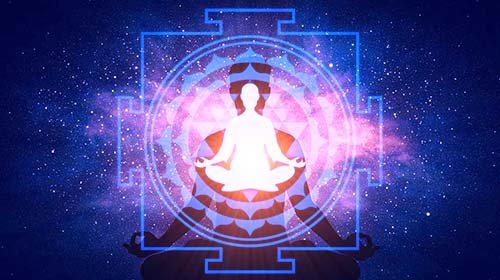
- Hang the Yantra on a wall facing North or East. Place the centre of the Yantra at the level of your eyes.
- Sit with spine straight and relax. Fix your eyes on the Bindu and see the whole Yantra at once. Continue gazing for 5 minutes.
- Then chanting the mantra of the yantra, start going outwards till you reach the doorway.
- Then again start from doorway and enter the focal point chanting the mantra at each stage.
- Repeat going inward as many times as 27 times, 54 times or 108 times.
- In time, after at least seven days of YANTRA meditation you will be able to tap into the same yantric energy even without a YANTRA.
- In time, you will not be able to tell whether the Yantra is within you or you are within the Yantra; this is the state of non-duality.

Shri Yantra is the most powerful amongst all the Yantras. It denotes energies of all Gods and Goddesses and is a representation of your entire Life which is a Play of Goddess Lalita. It is formed by the nine intertwining triangles that rim and exude out from the central point, the junction point between the material universe and its unmanifest source. Four of the triangles pointing upwards stand for Shiva. Five of these triangles pointing downwards stand for Shakti. It is a Yantra that takes you to your life purpose. All the divine architecture such as temples are based on this Yantra.
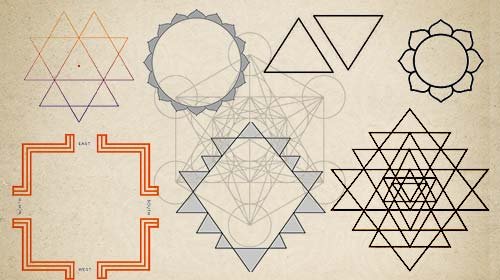
The Vedas state that a Yantra works in tune with the cosmological order. The geometrical shape of a Yantra produces a subtle cosmic force matching the invoked energy. When you chant a Vedic mantra dedicated to a Yantra, the layers of energy in the microcosm vibrate on the same wavelength with the corresponding energy current in the macrocosm. For instance, if you chant ‘Om Namah Shivay’ in front of an energized Shiva Yantra or Mahamrityunjaya Yantra (Deity Yantra), the Shiva Tattva (atomic elements connected with Lord Shiva) get charged up and you experience a meditative state within yourself. Therefore, Yantra are purely based on the Vedic science working as per the cosmological order.
Take any Yantra, you will always find the core components: bindu (dot), trikona (triangle), chakra (circle), shatkona (six-pointed star), bhupura (square) and Padma (divine lotus).
Bindu
It indicates the energy and its extreme concentration at the center. It is also called the center of cosmic radiation. Bounded by different surfaces such as a triangle, a hexagon, a circle, the bindu represents the union with the force or creative energy ruling the yantra.
Symbol
Shatkona
It is an archetypal amalgamation of two triangles structured in all the Yantra. It characteristically signifies the divine unification of Shiva (Male energy) and Shakti (Female energy) which is the cause of all creation.
Symbol
Bhupura
it represents the Earth Element that resides in the physical self. Yantra start with the dot and end with the square. It implies the way the cosmos evolves. It begins with the subtle energies at the centre, with granular at ether and then culminating in earth.
Symbol
Chakra
It stands for rotation which is central to the functioning of the macrocosmic progression. At the same time, the circle signifies perfection and the peaceful creative void of the Vishudha chakra. In the series of the five fundamental elements it represents the Air Element.
Symbol
Trikona
It is the emblem of Shakti, the absolute female energy of the Divine. It completes the creation or manifestation of both, material as well as spiritual worlds. The triangle pointing down characterizes the Yoni which is the source of all creations. Pointing upwards signifies forceful spiritual desire, the transferal of one’s nature into the subtler sphere and the Fire Element because Agni always burns upwards. A triangle pointing downwards represents the Water Element for water flows down. Fire Element represents Shiva and Water Element represents Shakti.
Symbol
Padma
All the Vedic scriptures as well as the scriptures of other faiths consider lotus to be the divine emblem of purity that resides in the chakras. A lotus in Yantra represents the unconditional force of the Supreme Absolute Truth. The lotus serves as a divine seat for devas (gods). It also represents detachment. It grows in the mud but never touches even a tinge of mud, representing detachment to the external forces (material world) and maintaining the original nature which is pure and divine.
Symbol

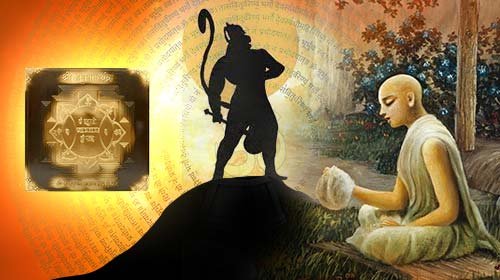
Yantras are the best substitutes for mantras to gain positive energy and get rid of the malefic effects of unfavorably placed planets. Some people are unable to chant mantras with correct pronunciation; a yantra is the solution for them. They create a distinctive but intangible atmosphere that is full of positivity and positive vibrations. The vibrations generated get us in contact with spiritual energies that enhance the soul from within. It increases the intensity of prayers and makes the thoughts stronger and more influential. The powers of a Yantra thrive on the reverberation of cosmic energies. When you concentrate on the center of a Yantra, your mind is pitched into the creative force associated with the yantra in question, and energy flows. Your wish and intention of prosperity and affluence along with a Yantra, say Kuber Yantra, is bound to yield more fruitful results as compared to an intention with the same wishes devoid of Kuber Yantra.
Thus, you may use a Yantra in the following ways:
You may meditate on the yantra to achieve resonance with the divine energy ruling the yantra. You may put it on your desk, wall, altar, or near the entrance. You may even put it in your vehicle. It creates a force field and charges the environment. You may wear it as a pendant, bracelet, ring or tabeez on your body. You may even carry the Yantra with you in your wallet (make sure that the wallet is not made of leather). The vibrations of the Yantra will create an aura of positive energy around you.
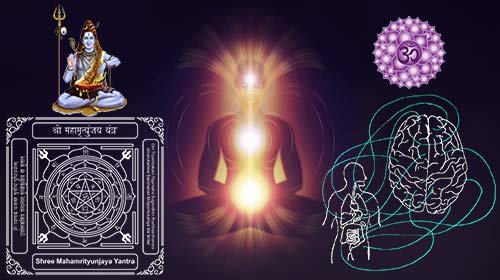
Yes. It does. Placing an energized Yantra in the appropriate direction influences one’s emotional, psychic, and bodily well-being. The core strength of a Yantra is that it energizes the subtle energy centres called chakras. All the chakras are ruled by a particular deity. For example, the Sahasrara Chakra is ruled by Lord Shiva. Worshipping a Mahamrityunjaya Yantra and meditating on the same gradually energizes this Chakra. An energized Sahasrara Chakra helps you know your place in the universe and see things as they are, making you undisturbed amid setbacks, failures, and general life problems. Yantra is best placed in the north-east part of the house as it is a confluence of positive energies coming from the geometric lines in the north and the rising sun in the east. However, if the north-east part is not convenient, then it is best to place them closer to you on your desk, on a wall or near the entrance door. Some Yantras offer results instantly if the karmic potential is ripe. Some offer results gradually over a long period of time. Yantra for wealth and affluence requires patience. For instance, Kuber Yantra works better after the first year. Yantra is also exceedingly helpful for health and averting accidents and mishaps.

Yantra are drawn on metals; they can be in Silver, Gold, Copper and Bhojpatra. Yantra, besides fulfilling their fundamental purpose, helps prosper in career along with good health, wealth, happiness and success. Yantra on the basis of their significance can be divided into following categories:
Deity Yantra
Yantra of the Great Mother or the Mahavidyas ‘Sources of supreme knowledge’ comes under deity Yantra. Most substantial of them all is Shakti Yantra.
Navgraha Yantra
Yantra that are used to harness the energies of the nine planets and are that of astrological significance comes under this category.
Architectural Yantra
Yantra that are used for the purpose of realty business success or to get rid of Vastu Dosha comes under the category of Architectural Yantra.
Numerical Yantra
These comprise of selected combinations of numbers which serve as talismans.
There are different Yantra for different purpose. One must be fully aware of the most appropriate Yantra for wish fulfillment and must check if they are worshipper of a particular God/Goddess before buying the Yantra. For instance, if one worships Goddess Ganesha, Ganesha Yantra can be highly beneficial and give faster results.
Similarly purpose wise, Bagalamukhi or Navagraha Yantra should be used if one is suffering from a disease or going through a court trial or facing any other monetary problem at professional or social front.
If one is facing unknown obstacles, using a Yantra as per the malefic planet in the birth chart helps get rid of them.
- Shree Yantra for name, fame, worldly pleasures, prosperity and salvation
- Mahalakshmi Yantra for money, food grains, for perfection, attainment of high goals
- Kuber Yantra for riches and preserving acquired money
- Ganesh Laxmi Business Yantra / Vyapaar Vridhi Yantra for progress in business and improvements in slow or quiet business
- Ganesh Yantra to begin pious and fortune giving deeds, attaining prosperity and accomplishment of goals
- Mahamrityunjaya Yantra for improving health, preventing disease and protection from untimely death
- Surya Yantra for worshipping the Sun, attaining glory, inner radiance and wordly pursuits
- Nav Graha Yantra for pacifying the nine planets, attaining peace and pleasure
- Hanuman Yantra to empower learning, increase wisdom and devotion to God
- Durga Yantra for worshipping Goddess Durga to remove pain and suffering
- Bagalamukhi Yantra to destroy enemies, success in law-suits and achievement in sports competitions
- Mahakali Yantra for worshipping Shakti, Goddess Mahakali to attain desired goals
- Batuk Bhairav Yantra to save from untimely death
- Durga Bisa Yantra to save from the evil eye, banish hindrance from evil spirits and achieve both progress and success in all realms
- Saraswati Yantra for improvements in learning, wisdom, grace and talents in the education & arts
- Gayatri Yantra for purifying the mind and ensuring good progress in life
- Vashikaran Yantra to attract the person you desire and bring him or her under your influence
- Santan Gopal Yantra to beget a child
- Mahasudarshan Yantra to get the grace of Lord Vishnu
- Ram Raksha Yantra for worshipping Lord Ram and succeeding in aspirations
- Kaal Sarp Yantra to negate the effect of Kaal Sarp Yoga and removing evil effects of the nine planets
- Bhuvaneshwari Yantra for gaining mesmerizing personality that draws all people towards him
- Dhumavati Yantra for all round success and spiritual upliftment
- Kamla Devi Yantra for elevation of the soul through both spiritual and worldly goals
- Mangal Yantra to negate the malefic effects of planet Mars and for luck in business & health
- Matangi Yantra for the attainment of great powers, power of speech and happiness in family life
- Rahu Yantra to negate the malefic effects of planet Rahu
- Shani Yantra to propitiate an afflicted Shani and achieve Rajayog
- Shiva Yantra to free the fear of death, grave dangers, fatal diseases and make courageous and healthy
- Tara Yantra for wealth and prosperity in life
- Guru Yantra for strengthening a weak Jupiter and get blessings in prosperity, power, rank, authority, abundance
- Shukra Yantra to negate the malefic effects of planet Venus and gain respect, love of opposite sex and peace of mind
- Ketu Yantra to negate the malefic effects of planet Ketu and gain all round success
- Chandra Yantra to negate the malefic effects of planet Moon and gain respect, friendship and create contacts with opposite sex in harmonious way
- Buddh Yantra to appease the planet Mercury or Buddh
- Manokamna Yantra changes one’s luck for the better, brings about desirable outcomes and makes manifest one’s deepest desires
- Sarva Siddhi Yantra most powerful yantra set comprising of the qualities of nine exclusive Yantra: Ganesh, Mahalaxmi, Saraswati, Durga Bisa, Shree Yantra, Durga, Mahamrityunjay, Batuk Bhairv
- Vahan Durghatna Yantra for protection from accidents, injury, or other mishaps, especially those related to vehicles
- Rog Nivaran Yantra to free the wearer from any fatal diseases and make him courageous and healthy
- Kamakshi Yantra prosperity, knowledge, fame and good progeny expeditiously in abundance
- Katyayani Yantra for success in love with auspiciousness and fruitful marriage
- Lakshminarayan Yantra invokes the blessings of Lord Vishnu and Goddess Lakshmi for complete happiness and success
- Swastik Yantra to prevent home from evil eyes
- Vaastu Yantra to remove Griha Dosha, Dik Dosha and negative energies

